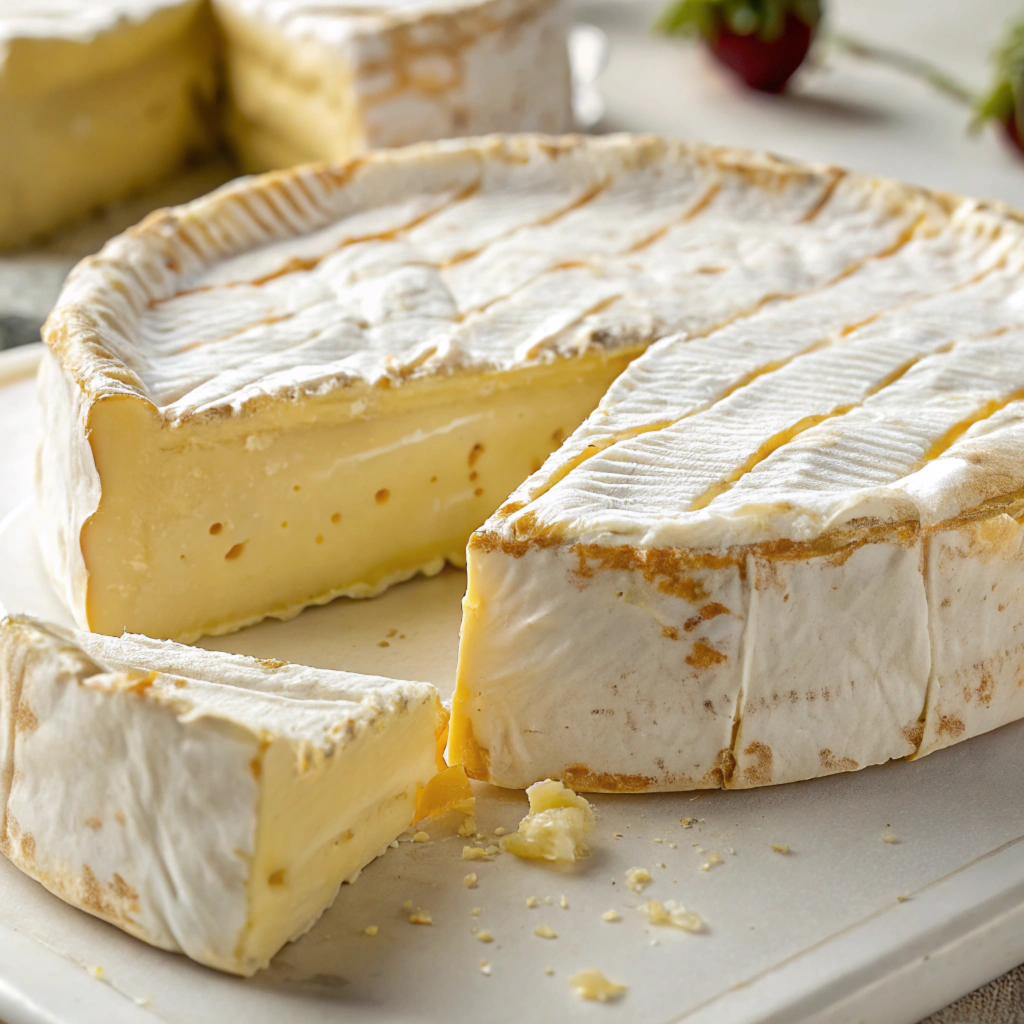
Brie, with its creamy texture and mild flavor, has become a staple on cheese boards and in recipes worldwide. However, whether to enjoy it hot or cold often sparks debate among food enthusiasts. This guide dives deep into the origins, characteristics, and serving temperatures of Brie to help you appreciate its full potential.
What Is Brie Cheese?
The Origins and Characteristics of Brie
Brie originates from France and is often referred to as the “Queen of Cheeses.” Named after the region where it was first made, this soft, bloomy-rind cheese boasts a white, edible crust encasing a creamy interior. Traditional Brie is known for its slightly nutty flavor, which intensifies as it ages.
Brie’s Creamy Texture and Mild Flavor Profile
The texture of Brie is one of its standout features. When served cold, it holds a firmer shape, while when warmed, it becomes luscious and gooey. Its mild taste makes it a versatile choice, pairing well with both sweet and savory accompaniments.
Why Temperature Matters When Serving Brie
How Temperature Affects Texture
The texture of Brie changes significantly with temperature. When chilled, it is firm and sliceable, making it ideal for platters and sandwiches. Conversely, when warmed, the cheese transforms into a creamy, spreadable delight, perfect for dips or baked dishes.
The Impact of Heat on Brie’s Flavor
Heat not only alters Brie’s texture but also enhances its flavor. Warming Brie intensifies its buttery and earthy notes, offering a richer experience. However, overcooking can lead to separation of oils, which diminishes its creamy consistency.
The Case for Eating Brie Cold
Serving Brie cold is a classic approach that allows you to appreciate its natural firmness and delicate flavor. This method is especially suitable for cheese boards, appetizers, and simple dishes that don’t require melting.
Serving Brie Straight from the Fridge
Best Pairings for Cold Brie
Cold Brie pairs beautifully with an array of accompaniments. Fresh fruits like apples, grapes, and pears provide a refreshing contrast to Brie’s creamy richness. Nuts such as almonds or walnuts, as well as light crackers or baguette slices, enhance the overall experience. For a sweeter pairing, honey or fruit preserves make excellent additions.
Using Brie in Salads and Sandwiches
Incorporating cold Brie into salads and sandwiches is another fantastic option. For salads, slice the cheese thinly and pair it with leafy greens, candied nuts, and a vinaigrette dressing. In sandwiches, Brie’s creamy texture complements deli meats like turkey or prosciutto and adds a gourmet touch.
Preserving Brie’s Firm Texture
Ideal for Cheese Boards and Appetizers
Cold Brie holds its shape well, making it an excellent choice for cheese boards and appetizers. It can be sliced into neat wedges or cubes, allowing for easy serving and pairing with other ingredients.
How to Properly Slice Cold Brie
To slice Brie effectively when cold, use a sharp knife warmed under hot water. This technique ensures clean cuts without squishing the cheese. Always slice Brie into small portions that include both the rind and creamy interior, offering the perfect balance of texture and flavor.
The Case for Eating Brie Warm or Hot
Warming Brie transforms it into a creamy, gooey indulgence that takes its flavor and texture to new heights. Whether baked, melted, or served warm, Brie becomes the star of any dish, adding richness and depth to your culinary creations.
Benefits of Heating Brie
Enhanced Creaminess and Depth of Flavor
Heating Brie amplifies its creaminess, making it perfect for spreading on bread or crackers. The heat also deepens its nutty, buttery flavors, creating a richer taste experience. This transformation elevates Brie to a luxurious treat ideal for entertaining.
Creating a Melting Effect for Dips and Recipes
Warmed Brie melts beautifully, making it an excellent choice for dips and recipes. The gooey consistency is perfect for blending with sweet or savory toppings, creating an irresistible centerpiece for gatherings or cozy evenings.
Popular Hot Brie Dishes
Baked Brie with Toppings
Baked Brie is a classic dish that’s both simple to prepare and impressive to serve. Toppings like honey, nuts, or fruit preserves add sweetness, while savory options like garlic, herbs, or caramelized onions bring complexity. Once baked, the Brie’s molten center becomes a decadent dip for crusty bread or crackers.
Recipe: Baked Brie with Honey and Walnuts
| Ingredients | Instructions |
|---|---|
| 1 wheel of Brie cheese | Preheat oven to 350°F (175°C). |
| 2 tbsp honey | Place the Brie on a baking sheet. |
| 1/4 cup chopped walnuts | Drizzle with honey and sprinkle walnuts on top. |
| Crackers or bread for serving | Bake for 10-15 minutes, until soft and gooey. |
Brie as a Topping for Warm Dishes

Warm Brie also works wonderfully as a topping for dishes like roasted vegetables, burgers, or even pizzas. The melted cheese adds a rich layer of flavor that complements a variety of ingredients, enhancing the overall dish.
How to Serve Brie at the Perfect Temperature
Serving Brie at the right temperature enhances both its texture and flavor. Achieving the perfect balance ensures that you can fully enjoy its creamy richness while preserving its delicate qualities.
Room Temperature Brie: The Best of Both Worlds
How to Bring Brie to Room Temperature Correctly
To serve Brie at room temperature, you need to remove it from the refrigerator at the right time. Ideally, this should be 30 to 60 minutes before serving. First, unwrap the Brie and place it on a serving platter. Next, cover it lightly with a cloth to prevent it from drying out. As a result, the cheese softens perfectly, making it smooth and spreadable.
Time Guidelines for Achieving Optimal Texture
It is essential to consider the size of the Brie when determining the timing. Smaller wedges typically take around 30 minutes to soften, whereas larger wheels may require up to an hour. To ensure the best results, check the cheese periodically and avoid letting it become overly warm, as this can result in an oily texture.
Balancing Temperature with Pairings
Choosing the Right Accompaniments for Warm Brie
Warm Brie pairs wonderfully with complementary ingredients. For instance, you can enhance its richness by adding sweet toppings like honey, dried fruits, or fig jam. Alternatively, savory additions such as roasted garlic, fresh herbs, or cured meats work well to balance the cheese’s creaminess.
When Cold Brie Works Best in a Dish
Cold Brie is ideal for recipes that emphasize its firm texture. For example, it can be sliced thinly and used in cold sandwiches for added creaminess. Furthermore, it shines in salads with fresh greens, crunchy nuts, and crisp vegetables. These pairings create a delightful mix of textures and flavors.
Tips for Heating Brie Without Overdoing It
Heating Brie can unlock its creamy, rich potential, but overdoing it can compromise its texture and flavor. By following the right methods, you can ensure your Brie remains indulgently smooth and delicious.
Methods to Warm Brie Safely
Baking, Microwaving, or Pan Heating Brie
There are multiple ways to heat Brie, and each method offers unique advantages. Baking is one of the most popular options, as it evenly warms the cheese and creates a melted center. To bake Brie, preheat the oven to 350°F (175°C), place the Brie on a lined baking sheet, and bake for 10–15 minutes.
Microwaving is a quicker alternative. However, it requires caution to avoid overheating. Place the Brie in a microwave-safe dish and heat it in 15-second intervals, checking frequently to ensure it softens evenly.
Pan heating is another option for recipes like Brie-topped burgers or grilled sandwiches. Heat the Brie gently over low heat to melt it without separating the oils.
Avoiding Overheating to Retain Creamy Texture
Overheating Brie can lead to an unpleasant, greasy texture. To prevent this, always monitor the cheese during the warming process. When the Brie begins to soften and ooze slightly, it is ready to serve. Avoid leaving it in the oven or microwave for too long, as this can cause it to lose its creamy consistency.
Enhancing Brie with Toppings When Hot
Sweet Toppings: Honey, Nuts, and Dried Fruits
Warm Brie pairs exceptionally well with sweet toppings. Drizzle honey over the melted cheese for a touch of sweetness, and sprinkle chopped walnuts or almonds for added crunch. Including dried fruits like cranberries or apricots elevates both the flavor and presentation.
Recipe: Baked Brie with Honey and Almonds
| Ingredients | Instructions |
|---|---|
| 1 wheel of Brie cheese | Preheat oven to 350°F (175°C). |
| 2 tbsp. honey | Place the Brie on a lined baking sheet. |
| 1/4 cup chopped almonds | Drizzle honey and sprinkle almonds on top. |
| Crackers or bread for serving | Bake for 10–15 minutes until gooey. |
Savory Additions: Herbs, Garlic, and Bacon
For a savory twist, add toppings like fresh herbs, minced garlic, or crumbled bacon to warm Brie. These ingredients balance the cheese’s richness and create a bold flavor profile. Serve with crusty bread or toasted crackers for a satisfying appetizer.
Popular Dishes Featuring Brie at Various Temperatures
Brie’s versatility makes it a star ingredient in both cold and hot dishes. Whether served fresh on a platter or baked into a decadent recipe, Brie adds sophistication and flavor to any meal.
Cold Brie Applications
Cheese Platters and Cold Sandwiches
Cold Brie is an excellent addition to cheese platters, offering a creamy and mild counterpoint to sharper cheeses. Pair it with fresh fruits like grapes and figs, as well as nuts and light crackers, for a balanced platter.
For sandwiches, Brie’s firm texture makes it easy to slice and layer. Combine it with smoked turkey, cranberry sauce, and arugula on crusty bread for a gourmet cold sandwich that is both flavorful and refreshing.
Incorporating Brie into Fresh Recipes
Cold Brie also works well in fresh recipes like salads. Slice the cheese thinly and pair it with mixed greens, candied walnuts, and a balsamic vinaigrette. Additionally, you can dice it into small cubes for a chilled pasta salad, where it complements vegetables like cherry tomatoes and cucumbers.
Hot Brie Recipes
Brie-Stuffed Pastries and Casseroles
When served warm, Brie transforms into a gooey delight. It is perfect for stuffing into puff pastries, creating elegant appetizers or snacks. Simply wrap a small wheel of Brie with pastry dough, top it with a dollop of jam, and bake until golden brown.
For casseroles, melted Brie adds a creamy richness to vegetable or chicken bakes. Mix it into the dish as a topping or blend it into the sauce for a luxurious texture.
Recipe: Brie-Stuffed Puff Pastries
| Ingredients | Instructions |
|---|---|
| 1 sheet puff pastry, thawed | Preheat oven to 375°F (190°C). |
| 1 small wheel of Brie | Cut the puff pastry into squares. |
| 2 tbsp fruit preserves | Place a piece of Brie and a teaspoon of preserves on each square. |
| 1 egg (beaten, for wash) | Fold the pastry over and seal the edges. Brush with egg wash. |
| Bake for 15–20 minutes, until golden brown. |
Combining Brie with Roasted Vegetables
Hot Brie pairs beautifully with roasted vegetables. Place slices of warm Brie over freshly roasted vegetables like butternut squash, Brussels sprouts, or carrots. The cheese melts slightly, adding a luxurious creaminess that complements the earthy flavors of the vegetables.
Factors That Influence How Brie Should Be Eaten
The best way to enjoy Brie often depends on several factors, including the type of Brie, its age, and the occasion. These considerations can help you decide whether to serve it cold, warm, or hot.
The Type of Brie Matters
Differences Between Traditional and Double Cream Brie

Traditional Brie tends to have a firmer texture and a more pronounced nutty flavor, making it suitable for both cold and warm applications. Double cream Brie, on the other hand, is richer and creamier due to its higher fat content. This type of Brie is ideal for recipes that require a gooey, melted consistency, such as baked Brie.
How Age Affects Brie’s Flavor and Versatility
As Brie ages, its flavor intensifies, becoming earthier and more robust. Younger Brie is milder and better suited for fresh, cold applications like cheese boards or salads. In contrast, aged Brie is perfect for warm recipes, as heating it enhances its complex flavors.
Occasion and Dish Type
When Warm Brie Is Ideal for Entertaining
Warm Brie works wonderfully for entertaining, as it creates a show-stopping centerpiece for gatherings. For example, baked Brie with sweet or savory toppings is a crowd-pleaser, offering an indulgent option for guests.
Casual vs. Formal Settings for Cold Brie
Cold Brie is better suited for more casual or formal settings, where simplicity and presentation are key. It’s easy to serve on cheese boards, alongside fresh fruits, nuts, and crackers, or as part of a light appetizer course.
FAQ: Common Questions About Eating Brie
1. Should Brie be eaten with or without the rind?
Brie’s rind is entirely edible and adds an earthy flavor to the cheese. Whether you eat it or not is a matter of personal preference.
2. Can you serve Brie directly from the refrigerator?
Yes, but for the best texture and flavor, it’s recommended to let Brie sit at room temperature for 30–60 minutes before serving.
3. What toppings go best with baked Brie?
Sweet toppings like honey, fruit preserves, and nuts are classic choices. Savory options like herbs, garlic, or bacon also pair beautifully with warm Brie.
4. How do you store leftover Brie?
Wrap Brie tightly in parchment paper or plastic wrap and store it in the refrigerator. Consume it within a few days for the best quality.
5. Can you freeze Brie?
While it’s possible to freeze Brie, doing so may affect its texture. It’s best to use frozen Brie in cooked dishes rather than serving it fresh.